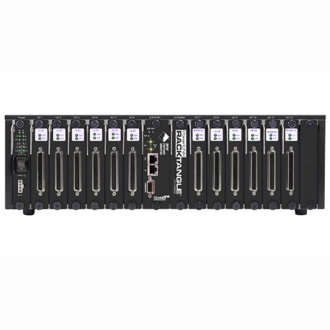The DNx-ECAT series of I/O chassis is based on UEI’s popular DNA-series Cubes and DNR series RACKtangles, but includes a CPU module specifically designed to run as an EtherCAT slave. The DNx-ECAT series offers all the I/O flexibility of the DNA Cubes and RACKs, including compatibility with over 60 different I/O boards while providing full EtherCAT compliance. EtherCAT developers can now harness the power, flexibility and ruggedness of the the UEI DNx family. The EtherCAT chassis are ideally suited for a wide variety of industrial, aerospace and lab data acquisition and control applications.
In general, the Ethernet is not ideal for real-time monitoring and control response though there are a number of ways to make it real-time. The EtherCAT is a special implementation of Ethernet designed to support real-time applications. (Note: UEI’s standard DNx-series Cubes and RACKs also support real-time I/O systems using our powerful DMAP/VMAP control protocols.).
EtherCAT chassis are typically configured one of two ways, with MDP or fixed configuration ESI files. MDP allows the EtherCAT master to interrogate the UEI-ECAT Chassis and automatically determine the boards installed and the functionality they provide. Alternatively, some EtherCAT masters require a single ESI file for each device. UEI supports both methods.
The CPU Module occupies the top portion of the Cube or center slot of the RACKtangle and provides the CPU, Ethernet Controller (NIC), indicator lights, configuration ports and internal power supply. It’s the brains of the Cube and controls the unit’s operations including the interface with the host Controller (and other Cubes) as well as supervising the activity of the I/O boards. The CPU module also includes rotary switches that set the chassis’ EtherCAT explicit device identification. If the switch is set to ECAT ID 0, the unit’s address is programmed by any EtherCAT master. In addition to connecting to other UEI chassis the DNx-ECAT series can be installed in any chain with ETG conforming devices.
The remainder of the chassis is dedicated to I/O slots. These slots are populated with the I/O modules selected to match your process or test application. With over 60 different I/O boards available we’re sure to have just what your application requires. We currently offer: A/D boards to measure voltage, current, strain gages, thermocouples and more, D/A boards with outputs to ±40V or ±50 mA, Digital I/O interfaces for logic and “real-world” signal levels, counters and timers, quadrature encoder inputs, RVDT/LVDT, and Communication interfaces for RS-232, RS-422/485.
The EtherCAT master/host communicates with the cube over standard CAT5e/6/7 series cables. One selling point of EtherCAT is it does not require Ethernet switches/routers for multi-chassis connectivity. The EtherCAT network is a daisy-chain where an input cable comes from the host/master and then an output cable goes to the next EtherCAT device in the chain. EtherCAT requires sub microsecond propagation for data parsing through a device so system throughput and synchronization is preserved. Other key EtherCAT specifications include: Built-in watchdog timers, Safe state default conditions and cable redundancy.

